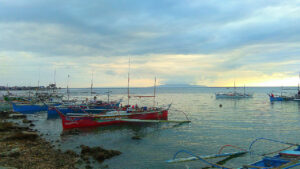The month of March 2023 marks three years since Luzon was placed under “enhanced community quarantine,” the beginning of what is now known as the one of the world’s longest and strictest lockdowns. What followed was an extended period of economic hardship for the entire country, during which the poorest, as usual, bore the worst consequences. Among the urban poor, some of those who lost employment, specifically jeepney drivers, turned to begging in the streets of Metro Manila. Elsewhere, the rural poor, such as the fisherfolk of Eastern Visayas, those who rely on catching and selling fish for income found their livelihood decimated by the pandemic and its attendant policies.
In the coastal town of Guiuan, Eastern Samar, the site of Super Typhoon Yolanda’s first landfall in 2013, fisherfolk have struggled with the combined onslaught of climate change and the effects of the pandemic.
A community leader from one island barangay confided in me last year that her fishing association lost 3,000 bangus (milkfish) to Typhoon Ursula in December 2019 and another 6,000 bangus to Typhoon Jolina in September 2021, a loss estimated to be in the hundreds of thousands of pesos. Once COVID-19 restrictions were imposed, the fisherfolk struggled to buy fish feed since they could no longer cross the border into Tacloban. (One fisherman told me that to circumvent the checkpoints, he and his fellows used pump boats to transport the fish feed when they couldn’t use the roads.)
And as the pandemic spread around the world, the buyers who would normally export their fish to Singapore and Europe stopped buying. Another community leader told me that they were hit hard by the combined effect of the pandemic and dishonest middlemen who, in her words, “say they didn’t profit even though they did. They earn 20 to 40 million [pesos] at a time, but the fishermen don’t.”
Furthermore, the fisherfolk resented the National Government’s blanket travel restrictions, as it increased their travel expenses while the closure of restaurants meant that they were forced to sell their catch at half price or dispose of it entirely.
Other fisherfolk claimed that they did not benefit from the Land Bank’s interest-free loans. Neither were they given the information on qualifications or criteria to avail themselves of the said loans.
And because of the nightly curfew imposed as a pandemic measure, the fishermen could only go out to sea when it was too late, past the ideal time to catch fish.
In many ways, the pandemic (and exacerbated by the government’s incoherent, politicized, and militaristic response) made poverty in the Philippines more acute. For the most vulnerable sectors, the precarious circumstances of pre-pandemic life gave way to collapse.
On the third anniversary of lockdown, the question to be asked is “what have leaders learned from the past three years?” Is it sufficient that we return to the precarity that made the consequences of the crisis so severe? Or has the very recent past taught us that precarious circumstances lead to disaster, and all it takes is an unlikely event?
Even as the worst of the pandemic seems over, we must nevertheless take stock of the tragedy that befell our people to prepare for future crises. We give attention to those marginalized like the fisherfolk from geographically isolated places. We need a sense of urgency to answer the questions and learn lessons.
Isabel Rodrigo is doing a study for Samdhana and Action for Economic Reforms regarding the pandemic’s impact on marginalized communities.










